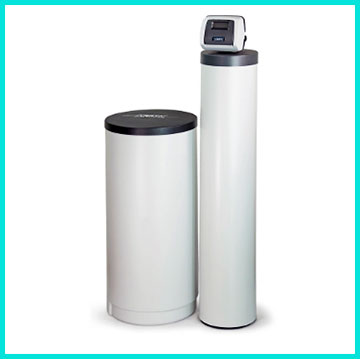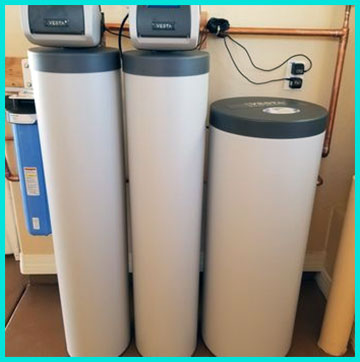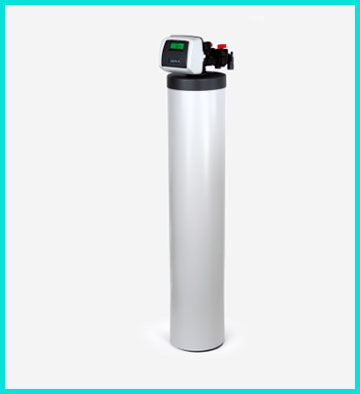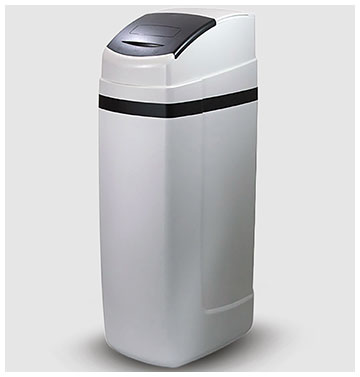If you’re tired of dealing with hard water’s annoying side effects—like spotty dishes, dry skin, or appliances that wear out too soon—the Vesta water softener might just be your new best friend.
I’ve lived with hard water my whole life, and after installing the Vesta, I can honestly say it’s transformed my daily routine.
From softer laundry to better-tasting coffee, this system delivers. In this review, I’ll share my personal experience, break down the pros and cons, offer maintenance tips, and compare Vesta to other brands. Trust me, you’ll want this in your home.
My Experience With Vesta Water Softener
When I moved into my new home, I quickly noticed the telltale signs of hard water: crusty faucets, stiff towels, and a faint metallic taste in my drinking water. My water test confirmed a hardness level of 20 grains per gallon (gpg), which is pretty high for a household of four.
After researching, I decided to give the Vesta Residential Series Water Softener a try, drawn by its sleek design and promise of low maintenance. I opted for the cabinet-style model, which fits neatly in my utility closet, and had a professional install it to ensure everything was set up correctly.

From day one, the difference was noticeable.
My morning shower felt like a spa experience—my skin wasn’t tight or itchy anymore, and my hair felt softer, almost like I’d used a fancy conditioner.
The Vesta’s dual media system, which includes activated carbon to remove chlorine and a resin bed for softening, made my tap water taste cleaner.
I even noticed my coffee tasted better, which is a big deal for someone who starts every day with a strong brew.
Dishes came out of the dishwasher spot-free, and my glassware sparkled like never before.
It’s the kind of change you don’t realize you need until you experience it.
The system’s control valve is a standout feature. It’s got a solid-state microprocessor that adjusts regeneration cycles based on my household’s water usage. This means it only regenerates when necessary, saving salt and water. I’ve got a family of four, and we use about 300 gallons a day for showers, laundry, and cooking. The Vesta handles it effortlessly, and I only need to refill the salt tank every six weeks or so.
The digital display is user-friendly, showing me when it’s time to add salt or schedule a manual regeneration. I also appreciate the battery backup, which keeps settings intact during power outages—a small but thoughtful touch.
One hiccup I encountered early on was a slight leak from the ozone tube in the brine tank, which I later learned was due to a missing check valve. A quick call to Vesta’s customer service sorted it out, though I was frustrated to learn that replacement parts aren’t easily found online.
The rep was helpful, but I had to pay a $90 service fee for a technician to fix it. That aside, the system has been reliable for the past two years, and I’ve noticed my appliances, like my washing machine, are running more efficiently with less scale buildup. Overall, my experience with the Vesta has been overwhelmingly positive, and it’s made me wonder why I didn’t invest in a water softener sooner.
Read More: My Thoughts On Waterboss Proplus 380
Pros Of Vesta Water Softener
- Improved Water Quality: The Vesta’s dual media system tackles both hardness and chlorine, leaving my water softer and better-tasting. Showers feel luxurious, and my skin and hair are noticeably healthier. Even my laundry comes out softer, which is a win for my kids’ sensitive skin.
- Efficient Salt and Water Use: The smart control valve monitors usage and only regenerates when needed, which cuts down on salt consumption. I use about one 40-pound bag of salt every six weeks, which is reasonable for my household’s needs.
- Compact Design: The cabinet-style model is a space-saver, fitting neatly in my utility closet. It’s perfect if you don’t have a big basement or garage. The two-toned gray finish looks modern and blends well with my home’s aesthetic.
- Long Warranty on Tanks: Vesta offers a 10-year warranty on the tanks, which gives me peace of mind about the system’s durability. It’s a solid investment, especially since the tanks are the heart of the system.
- Battery Backup: Power outages are common in my area, so the battery backup for the control valve is a lifesaver. It keeps all my settings intact, so I don’t have to reprogram anything after a storm.
- Chlorine Reduction: The activated carbon chamber removes chlorine, which not only improves taste but also extends the life of the softening resin. My water feels cleaner, and I’ve noticed less wear on my plumbing fixtures.
These benefits make the Vesta a standout choice for anyone dealing with hard water. The combination of efficiency, compact design, and water quality improvements has made a real difference in my home. It’s not just about convenience—it’s about protecting my appliances and improving my family’s quality of life.
Cons Of Vesta Water Softener

- Limited Warranty on Components: While the tanks have a 10-year warranty, the control valve and media only come with a 5-year warranty. I was disappointed to learn that parts like check valves aren’t covered, which added unexpected costs when I needed a repair.
- Parts Availability: Finding replacement parts online is a hassle. When I had an issue with the ozone tube, I couldn’t source the part myself and had to rely on Vesta’s service team, which felt inconvenient and costly.
- Service Fees: The $90 service fee for technician visits stung, especially since I’m used to DIY fixes. If you’re not handy or don’t have easy access to a Vesta dealer, this could be a recurring frustration.
- Initial Cost: The Vesta isn’t cheap, with prices starting around $999, not including installation. For my system, I paid about $1,500 with professional setup, which might be a stretch for budget-conscious households.
- Ozone Maintenance Issues: The ozone feature, meant to keep the brine tank clean, caused black residue buildup in my tank after two years. Flushing the system helped, but it’s an extra maintenance step I didn’t expect.
- Not Ideal for High Iron Levels: If your water has high iron content, like some well systems, the Vesta struggles. I had to add a pre-filter to manage minor iron in my city water, which added to the overall cost.
These drawbacks don’t outweigh the benefits for me, but they’re worth considering. If you’re on a tight budget or have complex water issues, you might need to weigh these cons carefully.
Maintenance Tips For Vesta Water Softener

- Check Salt Levels Regularly: I check my brine tank every 4-6 weeks to ensure it’s at least half-full with salt. This keeps the system running smoothly and prevents hard water from sneaking through during regeneration cycles.
- Use High-Quality Salt: I stick to solar salt, which Vesta recommends, as it’s purer and reduces residue in the brine tank. It’s a bit pricier, but it extends the life of the resin and keeps maintenance to a minimum.
- Clean the Brine Tank Annually: Once a year, I empty the brine tank and scrub it with soapy water to remove any sludge or black residue from the ozone system. It takes about 30 minutes but prevents clogs and keeps things sanitary.
- Flush the Ozone Tube: If you notice residue or leaks, flush the ozone tube as per the manual. I do this every six months to prevent buildup, using a simple water flush to clear the line.
- Inspect for Leaks: I check the system monthly for any drips or loose fittings, especially around the control valve. Catching leaks early saves you from costly repairs and water waste.
- Schedule Professional Checkups: Every two years, I have a technician inspect the system to ensure the resin and valves are in good shape. It’s about $100 per visit, but it helps avoid major issues down the line.
- Test Water Hardness: I use test strips every few months to confirm the system is softening effectively. If hardness creeps up, it might signal a need for resin cleaning or replacement.
These maintenance steps are straightforward and keep my Vesta running like a champ. They’ve saved me from major headaches and ensured consistent performance.
Comparison With Other Brands

SpringWell SS Series
SpringWell’s salt-based SS series is a strong competitor, boasting a high grain capacity of up to 48,000 and a Bluetooth-enabled control head. I found it delivers excellent water pressure, even in larger homes, but it’s pricier than the Vesta, often costing $1,200 or more. The app control is a nice touch, letting you monitor salt levels remotely, but it lacks the Vesta’s compact cabinet design, which was a dealbreaker for my small space. SpringWell’s resin lasts about 8-10 years, similar to Vesta, but its installation kit feels less DIY-friendly, requiring sturdier brass fittings.
SoftPro Elite
The SoftPro Elite is a mid-range option with user-friendly touch controls and a reputation for low maintenance costs. It’s slightly cheaper than Vesta, starting around $800, and offers a longer warranty on some components. However, I noticed it doesn’t handle chlorine as effectively as Vesta’s dual media system, which could be an issue for city water users like me. SoftPro’s app connectivity is a plus, but its flow rate (10 GPM) is lower than Vesta’s, which might cause pressure drops in busy households. It’s a solid choice if you prioritize affordability over advanced features.
Fleck 5600SXT
The Fleck 5600SXT is a budget-friendly workhorse, often priced under $700, with a reliable mechanical timer. It’s great for DIYers, as it’s easy to install and maintain, but it lacks Vesta’s smart regeneration technology, leading to more frequent salt use. I found its single-tank design less efficient for my family’s water usage, and it doesn’t reduce chlorine, which affects water taste. While it’s durable, with a 25-year lifespan potential, its lack of modern features like battery backup or a sleek design makes it feel dated compared to Vesta.
Kinetico Premier Series
Kinetico’s twin-tank system ensures soft water 24/7, even during regeneration, which is a big advantage for large households. It’s pricier, often exceeding $2,000, and its proprietary parts make repairs costly and hard to source. I appreciated its low maintenance—salt refills are needed only twice a year—but the Vesta’s compact design and chlorine removal won me over. Kinetico’s non-electric operation is eco-friendly, but its high upfront cost and lack of digital controls make it less appealing for tech-savvy users like me.
Aquasure Serene Lite
For those considering salt-free options, the Aquasure Serene Lite is a low-maintenance alternative that prevents scale without removing minerals. It’s cheaper, around $600, and requires no salt refills, but it doesn’t soften water as effectively as Vesta’s salt-based system. I found it less effective for my high-hardness water, leaving some soap scum behind. It’s great for eco-conscious households or rentals, but if you want the full softening experience, Vesta’s dual media system outperforms it in water quality and appliance protection.
Each brand has its strengths, but Vesta’s balance of efficiency, design, and water quality improvements makes it my top pick for most homes.
Read More: My Thoughts On Flagship Water Filtration System
Frequently Asked Questions (FAQ)
Vesta water softeners are manufactured by Nelsen Corporation, a well-known name in the water treatment industry. They assemble their systems using reliable valves from brands like Clack, Fleck, and Autotrol, ensuring quality and durability. Nelsen’s focus on residential solutions makes Vesta a trusted choice for homeowners like me.
Choosing the best brand depends on your needs, but Vesta stands out for its compact design and efficient dual media system. SpringWell and SoftPro are also excellent for their smart features and affordability, respectively. For high-demand households, Kinetico’s twin-tank system is hard to beat, but Vesta’s balance of cost and performance makes it a versatile option.
Some states, like California, Texas, and Arizona, have local regulations restricting salt-based water softeners due to environmental concerns about brine discharge. These bans often apply to specific counties or cities, like Los Angeles or San Antonio, where wastewater treatment plants face sodium overload. Check local ordinances before installing a system like Vesta.
A well-maintained water softener, like the Vesta, typically lasts 10-15 years. The resin bed may need replacement after 5-10 years, depending on water quality and usage. Regular maintenance, like checking salt levels and cleaning the brine tank, can extend its lifespan significantly.
Conclusion: For Vesta Water Softener
If hard water is wreaking havoc on your home, the Vesta water softener is a smart investment. It’s transformed my daily life with softer water, better-tasting drinks, and happier appliances. Despite minor drawbacks like parts availability and service fees, its efficiency, compact design, and long-term benefits make it a winner. You’ll love the difference it makes in your showers, laundry, and peace of mind. Get a Vesta and say goodbye to hard water woes—you won’t regret it.
